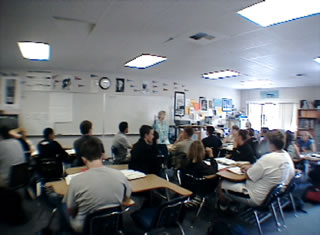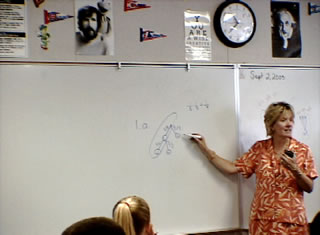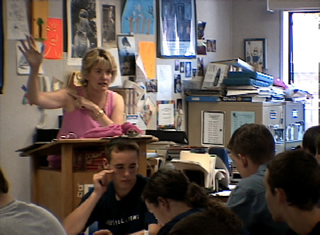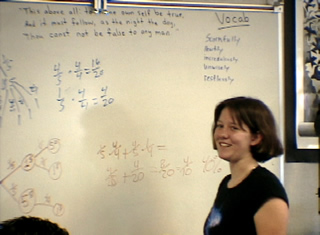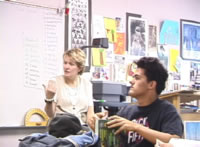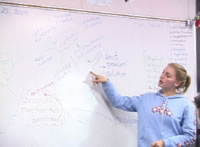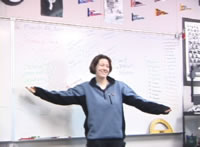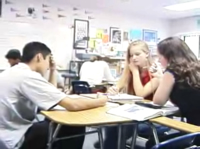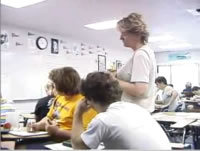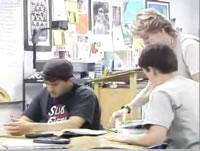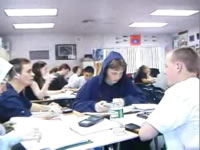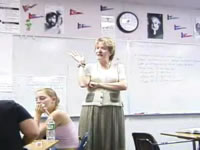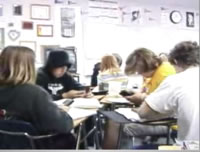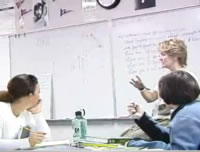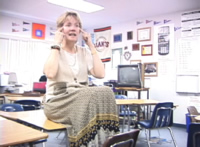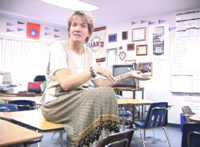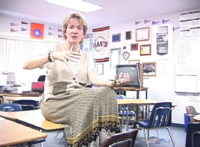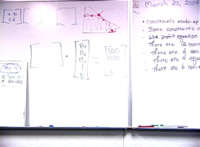Archive of Practice
Documentation of Teaching • Reflections on Teaching • Context & Materials
|
Documentation of Teaching
|
Highlights from the first weeks of the year |
Selected clips from August 2004, Interactive Mathematics Program 3 (IMP) with 28 students, 9-12 grade. |
|
|
|
I don’t believe in starting the year with a bunch of rules. I prefer, instead, to have situations arise, and then we can discuss the relevant rules in context. This way, instead of listing 25 rules or so about hats, bells, bathroom, etc. which they invariably will have trouble remembering, it all makes sense to my students, Also, kids like to know why you’re making the rule that you’re making. For example, this is a junior level class, so I ramp things up. They know that in order to be treated more like an adult, it is my expectation that they act more like an adult. This includes greater academic rigor, conscientious drinking and eating in class, and appropriate dress in the workplace. Speaking of dress, it is very important to me that I do not have to embarrass anyone by calling attention to inappropriate dress. I lay it out ahead of time exactly what I feel is “across the line” so there are no surprises. That goes for language as well. And finally, kids often attempt to hide under hats and the like. I tell my students that it is important for me to see their eyes. It’s about being connected. |
|
|
Homework is graded for completion and effort. I do not score homework based on the number of answers right or wrong. In order to determine how thoroughly the students did a homework assignment, I ask that they have it out on their desks and I walk through and stamp the student work. The location of the stamp indicates to me later how much of the assignment was completed at home. Students are free to revise their homework responses as we discuss it in class. I later review the homework that the students have left in their table’s folder after class and award points that go in my grade book. The folders are very efficient. I only need to pass out 6 things (folders) instead of distributing 30 papers. The same folders last throughout the year. By the way, my rubber stamp collection is expanding and the kids enjoy it when the stamp relates to the theme of our unit of study.
More and more students live in two households, and I work to provide those students with any resources that may make the homework process smoother for them. Homework, in time, will stop counting directly as part of their grade. With a senior level class, I wean them off of this system emphasizing that while homework is essential to complete, at the college level it is rarely collected. |
|
|
I wait to explain my system of crediting students for participation until we indeed have a situation in which a student will work at the board and present work to classmates. It is important to me that the kids know that I value thinking and speaking out loud. At first, table groups determine themselves who will come forward, but later I am careful to select various students. Initially, “braver” students present and are engaged and modeling good participation, how to explain thinking, and how to stand so others can see. Interestingly, my colleagues in our English department commented to me about the growing confidence of our students in going up to discuss things in front of the class. When asked, students often mention math class as where they learned this important life skill. |
|
|
Early in the year I try to make it very clear that the students are free to ask questions. In fact, I need to get their questions to determine what they know and don’t know. In this clip, a question clued me in that I needed to back up to deal with basic probability. It was also very helpful to hear that a student was unsure about proportional reasoning. Students are also encouraged to interject when they don’t understand a previous question or explanation. I often praise students directly for asking questions. I also leave the students’ work on the board for quite some time. This allows me to compare and contrast various representations and to discuss how and when an approach may have wandered off course. |
|
|
I reiterate to students that it is their responsibility to ask questions and to state it openly when they do not understand something in class. They are, of course, helping themselves when they do so, but I remind them that they are also being helpful to the entire group when they ask for clarification. |
|
|
Students need to feel acknowledged for taking the risk of going to the front of the class, especially when they may not be entirely comfortable with the content. I welcome applauding and other forms of encouragement. In time, I like to see the students posing questions to one another directly without teacher facilitation. When this occurs, I often make my way to the back of the room to observe. This maintains focus on the work being shared. It’s a great feeling to see the students engaged at this level. While I am not directly presenting, I feel very much in control of the class, and am, in fact, cleverly orchestrating things from the rear of the room. I also emphasize that one example is not always sufficient to learn something new, and I again urge the student to clue me in when they feel lost. |
|
Class Instruction, IMP 3
March 23, 2004 |
One class period of Interactive Mathematics Program 3 (IMP) with 28 students, 9-12 grade. |
|
|
Introduction
I explain why the class is being videotaped. |
|
Preparing for the unit problem |
(mm:ss) |
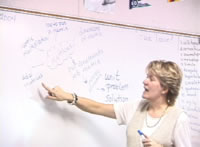 |
| I introduce the unit problem by taking the class on a "backwards journey." |
play
|
Quicktime Player
high • low
get plugin |
Windows Media
high • low
get plugin |
|
Preparing for the unit problem
I introduce the "unit problem" by taking the class on a backwards journey: "where we've been, what are the important places we've been that will enable us to solve the unit problem." |
|
| |
PICTURES FROM THE CLASS TEXT BOOK....
[click each image below for larger view]
|
|
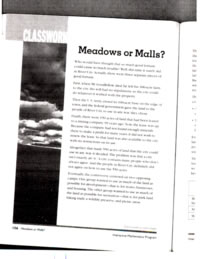 |
The unit problem, "Meadows or Malls?" page 1 |
|
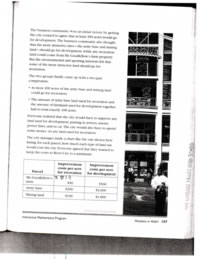 |
The unit problem, "Meadows or Malls?" page 2 |
|
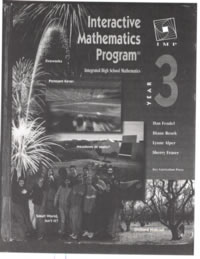 |
Gilliam's class textbook |
|
Small Groups at Work
|
(mm:ss) |
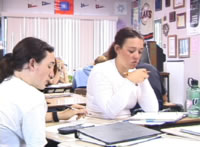 |
| Groups work together. I walk around and check in with groups. |
play
|
Quicktime Player
high • low
get plugin |
Windows Media
high • low
get plugin |
|
Small groups at work
[audio quality varies]
Groups work together. I walk around and check in with groups.
|
|
|
Whole group discussion,
Groups 1 and 2
Each group records a contribution on the board and explains their thoughts to the class. With the second group, I ask the class to help clarify ideas. |
|
|
Whole group discussion,
Groups 3 and 4 |
|
|
Whole group discussion,
Groups 5 and 6 |
|
|
Whole group discussion,
Groups 7 and 8
I point out, after group 7, that two things are missing. |
|
| |
FOUR IMAGES OF THE BOARD
[click each image below for larger view] |
|
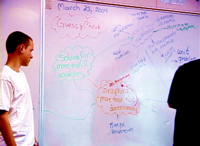
|
(jpg)
|
|
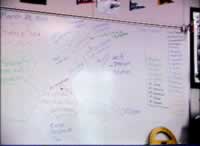 |
(jpg) |
|
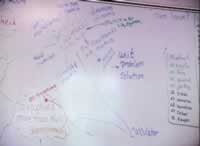 |
(jpg) |
|
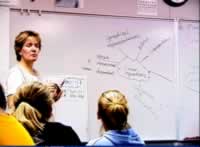 |
(jpg) |
|
Whole Group: Constraints
|
(mm:ss) |
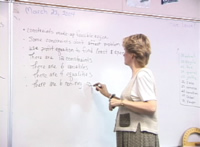 |
| Generating a descriptive, factual list about the constraints. |
play
|
Quicktime Player
high • low
get plugin |
Windows Media
high • low
get plugin |
|
Whole group discussion, Constraints
The class begins by generating a descriptive, factual list about the constraints.
The previous night's homework: look at the original constraints and try to figure out which ones can be crossed out. |
|
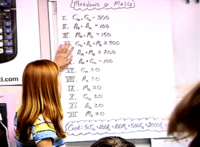
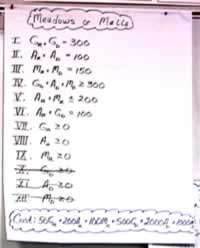
|
Constraints
(2 photos of chart paper) |
|
Whole Group : Eliminating Constraints (1)
|
(mm:ss) |
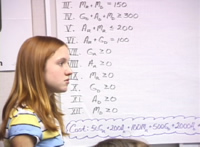 |
| Students take on the challenge of explaining which constraints can be eliminated and why. |
play
|
Quicktime Player
high • low
get plugin |
Windows Media
high • low
get plugin |
|
Whole group discussion, Eliminating constraints
Students approach the board to explain which constraints can be eliminated and why. Keeping their train of thought proves to be very challenging, and the class is patient and supportive.
Ashley, Russell and Simon (who both lose their thoughts at the board and sit down to try to remember), Gregg. I ask Gregg to repeat his thoughts because she gets confused. Ashley joins him at the board to help explain. I help the class see that Ashley has most frequently been using the equations with the most variables and the equalities. |
|
Whole Group : Eliminating Constraints (2)
|
(mm:ss) |
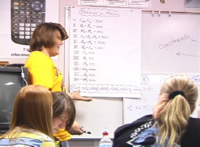 |
| Students take on the challenge of explaining which constraints can be eliminated and why. |
play
|
Quicktime Player
high • low
get plugin |
Windows Media
high • low
get plugin |
|
Whole group discussion, Eliminating constraints 2
Russell and Ashley return to the board. Class takes a 5-minute break.
During the break, several students approach the board to continue working on the problem. After the break, Jerry goes to the board.
|
|
 |
Image of the board (jpg)
[click image for larger view] |
|
Whole Group: Solving the
Unit Problem
|
(mm:ss) |
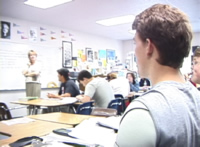 |
| The class discusses steps for solving the unit problem. |
play
|
Quicktime Player
high • low
get plugin |
Windows Media
high • low
get plugin |
|
Whole group discussion, Solving the unit problem
"With these constraints eliminated... what's the procedure we're gonna use to be able to solve the unit problem, in general?" |
|
| |
|
|
Small groups work on unit problem
|
[audio quality varies in clips below]
Groups work together. I check in with groups. |
|
|
|
|
|
|
Clip 5: I interrupt small group work to make a class announcement regarding checking answers, and then later, regarding the question, "Do I multiply the answer by the inverse or do I multiply the inverse by the answer?" |
|
|
|
|
| TEXTBOOK IMAGES |
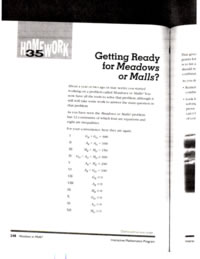 |
Homework for the unit problem, "Meadows or Malls?" page 1 |
|
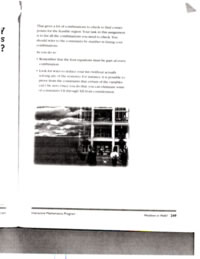 |
Homework for the unit problem, "Meadows or Malls?" page 2 w |
|
Reflections on Teaching
|
| Reflections, March 23, 2004 |
|
|
Clip 1: General Reflections
|
(mm:ss) |
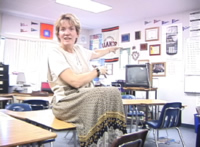 |
| I reflect on the lesson and comment on trying out backwards-mapping. |
play
|
Quicktime Player
high • low
get plugin |
Windows Media
high • low
get plugin |
|
Clip 1: General reflections
I reflect on the lesson and comment on trying out backwards-mapping.
“Sometimes for me, I don’t plan everything out…” I comment on “flow” and tying things together in a lesson. Also:
- How students built upon each other’s thinking.
- Her own questions about stopping for the break, and how exciting it is too see kids at the board during the break.
- Stopping group work to discuss particular student questions with the whole class.
- The importance of moving backwards to move forward, the importance of “reviewing the journey,” a “collective reflection.”
|
|
|
Clip 2: The role of backwards-mapping |
|
|
Clip 3: Surprising moments |
|
|
Clip 4: Setting up a “low-risk” environment |
|
|
Clip 5: Advice for new teachers
...with respect to establishing classroom norms. I refer to documentation of my first 2 weeks of school (clips forthcoming). I discuss the importance of asking students to go to the board. |
|
|
Clip 6: Setting up group problem-solving |
|
Clip 7: Setting up a
"low-risk" environment 2
|
(mm:ss) |
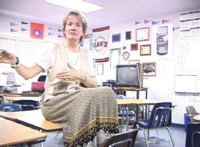 |
| I comment on the teacher's physical position in the room (front v. back of room). |
play
|
Quicktime Player
high • low
get plugin |
Windows Media
high • low
get plugin |
|
Clip 7: Setting up a “low-risk” environment 2
I comment on the teacher's physical position in the room (front v. back of room). |
|
|
Clip 8: Designating small groups
|
|
|
Clip 9: Remaining questions, concerns |
|
Pedagogical Context & Materials
|
| San Lorenzo Valley High School |
Link to school website,
http://www.slvhs.slv.k12.ca.us/ |
|
| About me (pdf) |
Contextual information |
|
| About My School & This Class (pdf) |
Contextual information |
|
Interactive Mathematics Program
http://www.mathimp.org/ |
More about IMP, the curriculum, and related research |
|
| Summary of my inquiry (pdf) |
Written 6/19/03 |
|
| Article abstract |
Related resources: Goos, M. (2004). Learning Mathematics in a Classroom Community of Inquiry. Journal for Research in Mathematics Education, 35 (4), 258-291. |
|
| NCTM Journal |
http://my.nctm.org/eresources/journal_home.asp?journal_id=1
|
|
 Learning Mathematics
Learning Mathematics 